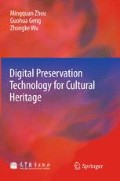Abstract
Calligraphy and painting have been highly valued throughout the history of China and recognized as a typical expression of Chinese traditional arts. Calligraphy and painting in China have their pursuits in exterior beauty and a focus of the inner lyrical mood that are stressed collectively. However, due to temperature, humidity and other natural conditions and human factors, calligraphy works and paintings, made on paper, silk or other delicate materials, are rarely kept well. With the development of computer and data acquisition technology using computer image processing to achieve efficient restoration of paintings has great research and application values. This chapter firstly describes the different types of incomplete paintings, and then shows the image segmentation and contour tracing technology areas to be achieved, and finally show how to use the Bertalmio Sapiro Caselles Batlester (BSCB) model, Total Variation (TV) model, and curvature driven diffusions (CDD) to realize the implementation of defective areas.
Access this chapter
Tax calculation will be finalised at checkout
Purchases are for personal use only
Preview
Unable to display preview. Download preview PDF.
References
Jin F (2008) Restoration of Silk Painting of Wu Zhuo in Qing Dynasty. Cultural Relics of Central China, (6): 103–106
He B, Ma T, Wang Y, et al (2002) Visual C++ Digital Image Processing (the Second Edition). Posts & Telecom Press, Beijing
Davis L (1975) A Survey of Edge Detection Techniques. Computer Graphics and Image Processing, 4(3): 248–270
Prewitt J (1970) Object Enhancement and Extraction. In: Lipkin BS, Rosen-feld A (eds) Picture Processing and Psychopictories, pp 75–149, Academic Press, New York
Kirsch R (1971) Computer Determination of the Constituent Structure of Biological Images. Computers and Biomedical Research, 4(3): 315–328
Bertalmio M, Sapiro G, Caselles V, et al (2000) Image Inpainting. In: Proceedings of the 27th Annual Conference on Computer Graphics and Interactive Techniques, pp 417–424, New Orleans, Louisiana, USA, 23–28 July 2000
Chan T, Shen J (2001) Non-texture Inpainting by Curvature-Driven Diffusions (CDD). Journal of Visual Communication and Image Representation, 12(4): 436–449
Geman S, Geman D (1984) Stochastic Relaxation, Gibbs Distributions, and the Bayesian Restoration of Images. IEEE Transactions on Pattern Analysis and Machine Intelligence, PAMI—6(6): 721–741
Rudin L, Osher S, Fatemi E (1992) Nonlinear Total Variation Based Noise Removal Algorithms. Physica D, 60(1–4): 259–268
Chan T, Kang S, Shen J (2002) Euler’s Elastica and Curvature-based Inpainting. SIAM Journal on Applied Mathematics, 63(2): 564–592
Tsai A, Yezzi A Jr, et al (2001) Curve Evolution Implementation of the Mumford-Shah Functional for Image Segmentation, Denoising, Interpolation and Magnification. IEEE Transactions on Image Processing, 10(8): 1169–1186
Esedoglu S, Shen J (2002) Digital Inpainting Based on the Mumford-Shah-Euler Image Model. European Journal of Applied Mathematics, 13(4): 353–370
Zhang H, Peng Q (2007) A Survey on Digital Image Inpainting. Journal of Image and Graphics, 12(1): 1–10
Tian Y (2008) Research of Image Inpainting Models Based on PDE. Dissertation, Northwest University, Xi’an, China
Perona P, Malik J (1990) Scale-Space and Edge Detection Using Anisotropic Diffusion. IEEE Transactions on Pattern Analysis and Machine Intelligence, 12(7): 629–639
Catte F, Lions P, Morel J, et al (1992) Image Selective Smoothing and Edge Detection by Nonlinear Diffusion. SIAM Journal on Numerical Analysis, 29(1): 182–193
Stanley O, Sethian J (1988) Fronts Propagating with Curvature-Dependent Speed: Algorithms Based on Hamilton-Jacobi Formulations. Journal of Computational Physics, 79(1): 12–49
Marquina A, Osher S (2000) Explicit Algorithms for a New Time Dependent Model Based on Level Set Motion for Nonlinear Deblurring and Noise Removal. Journal on Scientific Computing 22(2): 387–405
Chan T, Shen J (2002) Mathematical Models for Local Non-texture Inpaintings. SIAM Journal on Applied Mathematics, 62(3): 1019–1043
Author information
Authors and Affiliations
Rights and permissions
Copyright information
© 2012 Higher Education Press, Beijing and Springer-Verlag Berlin Heidelberg
About this chapter
Cite this chapter
Zhou, M., Geng, G., Wu, Z. (2012). Virtual Restoration Techniques of Calligraphy and Painting. In: Digital Preservation Technology for Cultural Heritage. Springer, Berlin, Heidelberg. https://doi.org/10.1007/978-3-642-28099-3_6
Download citation
DOI: https://doi.org/10.1007/978-3-642-28099-3_6
Publisher Name: Springer, Berlin, Heidelberg
Print ISBN: 978-3-642-28098-6
Online ISBN: 978-3-642-28099-3
eBook Packages: Computer ScienceComputer Science (R0)

